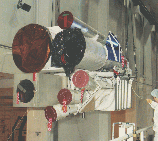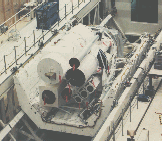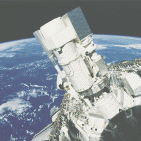|
|||||||||||||||||||
|
|
|||||||||||||||||||
|
|



Photo captions: (left) The Astro telescopes at NASA/KSC before attachment to the Instrument Pointing System. (middle) The integrated payload, ready for flight. (right) The telescopes on-orbit during Astro-1 in December 1990.
HUT AND THE ASTRO OBSERVATORY
HUT is one of three primary telescopes that comprise the Astro Observatory. The other telescopes are the Wisconsin Ultraviolet Photo-Polarimeter Experiment (WUPPE), built at the University of Wisconsin, Madison, and the Ultraviolet Imaging Telescope (UIT), built at the NASA/Goddard Space Flight Center. These telescopes all grew out of NASA's sounding-rocket program and were selected in 1978 for development to fly aboard the space shuttle on a series of missions. The telescopes were designed to be operated as an attached payload, meaning that they were to be used directly from the payload bay of the shuttle itself. The telescopes use many components of NASA's Spacelab system, and are aligned on the Spacelab Instrument Pointing System ( IPS ). Hence, all three telescopes point in the same direction at the same time, making joint observations possible.
Each of these telescopes provides a unique capability that complements other NASA payloads or satellites. HUT extends coverage to wavelengths of UV light that are beyond the grasp of other space telescopes, covering a spectral region of great scientific interest. UIT obtains sensitive photographs at various UV wavelengths; each image covers a circular field of 40 arc minutes (or 2/3rds of a degree), which is over 250x larger than Hubble Space Telescope's widest field camera. WUPPE not only performs spectroscopy in the near-UV region but can measure the polarization of the UV light, which often provides unique information about magnetic fields, interstellar dust, and the geometry of stellar systems. Simultaneous observations by two or even all three telescopes often provide additional information about the astronomical objects being observed.
The three telescopes were next in line awaiting a March 1986 launch to observe Halley's comet at the time of the Challenger disaster in January 1986. When the shuttle returned to service two-and-a-half years later, the Observatory was scheduled for flight in April 1990. An X-ray telescope called the Broad-Band X-ray Telescope (BBXRT) was added to the mission to take advantage of the unique opportunity provided by the bright supernova called SN1987A, which exploded in a nearby galaxy in 1987. BBXRT was built at NASA's Goddard Space Flight Center and was operated from a separate pointing system from the UV telescopes. Various delays pushed the launch into late 1990. Finally, on December 2, 1990, the Astro-1 mission was launched on the space shuttle Columbia for an 8-day science mission. Hopkins astronomer Samuel Durrance was aboard as a payload specialist for the mission.
Numerous technical glitches occurred during the operational phase of the Astro-1 mission, but scientifically the mission was very successful, resulting in over 120 published results by all four instrument teams. In May 1991, NASA announced that it would fly the UV payload again as the Astro-2 mission in late 1994 or early 1995. (The capabilities of the X-ray telescope were duplicated by other instruments planned for launch shortly after that time.) Much effort during the next several years went into resolving technical difficulties with the Instrument Pointing System for the telescopes, streamlining and adding flexibility to the procedures used in mission planning, and making improvements to the telescope. HUT was the only instrument upgraded significantly for the second mission.
In stark contrast to the launch delays incurred on Astro-1, the Astro-2 mission launched exactly as planned on March 2, 1995, once again carrying Sam Durrance and six other astronauts. Astro-2 used the space shuttle Endeavour, which was equipped with a special energy kit that extended its on-orbit capability to 16 or more days. Astro Observatory Operations continued around the clock, involving coordinated activities by the astronauts from the shuttle's aft flight deck and a large contingent of scientists, engineers, and support people at NASA's Marshall Space Flight Center in Huntsville, AL, and Johnson Space Center in Houston, TX. Operations went extremely smoothly during Astro-2, ultimately stretching out to a record 16-1/2 days, the longest shuttle mission to date. A tremendous wealth of astronomical data was obtained and is in the process of being analyzed and published by the science teams. (See Scientific Results from HUT for some examples.)
In case you missed them above, here are a few key links to related information:
- Astro-1 Mission Summary
- Astro-2 Mission Summary
- Mission Planning for Astro
- Astro Observatory Operations
|
|
|




 Follow Us
Follow Us